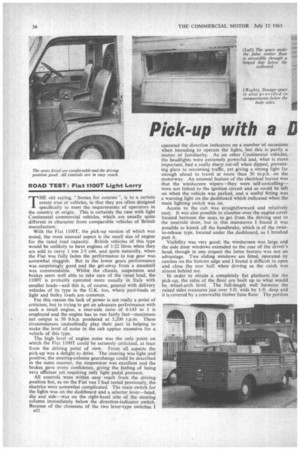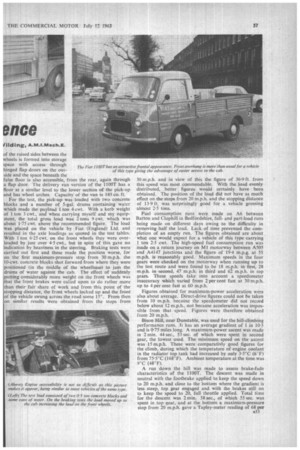Pick-up with a fi once
Page 58

Page 59

Page 60

If you've noticed an error in this article please click here to report it so we can fix it.
Vi!ding, A.M.I.Nlech.E. operated the direction indicators on a number of occasions when intending to operate the lights, but this is partly a matter of familiarity. As on other Continental vehicles, the headlights were extremely powerful and, what is more important, had a really sharp cut-off when dipped, preventing glare to oncoming traffic, yet giving a strong light far enough ahead to travel at more than 50 m.p.h. on the motorway. An unusual feature of the electrical layout was that the windscreen wipers—they were self-cancellingwere not linked to the ignition circuit and so could be left on when the vehicle was parked, and a useful fitting was a warning light on the dashboard which indicated when the main lighting switch was on.
Access to the cab was straightforward and relatively easy. It was also possible to clamber over the engine cover located between the seats to get from the driving seat to the nearside door, but in this manceuvre I found it was possible to knock off the handbrake, which is of the twistto-release type, located under the dashboard, as I brushed past it,
Visibility was very good; the windscreen was large and the side door windows extended to the rear of the driver's head, though in one respect the latter feature was not an advantage. Two sliding windows are fitted, operated by catches on the bottom edge and I found it difficult to open and close the rear half when driving as the catch was almost behind me.
In order to obtain a completely flat platform for the pick-up, the sides of the floor are built up to what would be wheel-arch level.. The full-length well between the raised sides measures just over 3-ft. wide by 1-ft, deep and it is covered by a removable timber false floor. The portion of the raised sides between the wheels is formed into storage space with access through hinged flap doors on the outside and the space beneath the false floor is also accessible, from the rear, again through a flap door. The delivery van version of the 1100T has a floor at a similar level to the lower section of the pick-up and has wheel arches. Capacity of the van is 185 cu. ft.
For the test, the pick-up was loaded with two concrete blocks and a number of 5-gal, drums containing water which made the payload 1 ton 4 cwt. With a kerb weight of 1 ton 3 cwt„ and when carrying myself and my equipment, the total gross load was 2 tons 9 cwt. which was about 1-75 cwt. above the recommended figure. The load was placed on the vehicle by Fiat (England) Ltd. and resulted in the axle loadings as quoted in the test tables. With 1 ton 6-25 cwt. on the front wheels they were overloaded by just over 4-5 cwt., but in spite of this gave no 'indication by heaviness in the steering. Braking tests were carried out first and these made the position worse, for on the first maximum-pressure stop from 30 m.p.h. the 10-cwt. concrete blocks shot forward from where they were positioned (in the middle of the wheelbase) to jam the drums of water against the cab. The effect of suddenly putting considerably more weight on the front wheels was that the front brakes were called upon to do rather more than their fair share of work and from this point of the stopping distance, the front wheels locked up and the front of the vehicle swung across the road some 15°. From then on similar results were obtained from the stops from 30 m.p.h. and in view of this the figure of 36-9 ft. from this speed was most commendable. With the load evenly distributed, better figures would certainly have been obtained. The position of the load did not have as much effect on the stops from 20 m.p.h. and the stopping distance of 13-9 ft. was surprisingly good for a vehicle grossing almost 2-5 tons.
Fuel consumption runs were made on A6 between Barton and Clophill in Bedfordshire, fulland part-load runs being made on different days owing to the difficulty in removing half the load. Lack of time prevented the completion of an empty run. The figures obtained are about what one would expect for a vehicle of this type carrying 1 ton 2,5 cwt. The high-speed fuel consumption run was made on a return journey on M1 motorway between A505 and A4147 junctions and the figure of 19-4 m.p.g. at 55 m.p.h. is reasonably good. Maximum speeds in the four gears were checked on the motorway when running up to the test route and were found to be 18 m.p.h. in first, 28 m.p.h. in second, 47 m.p.h. in third and 62 m.p.h. in top gears. These speeds take into account a speedometer inaccuracy which varied from 2 per cent fast at 30 m.p.h. up to 4 per cent fast at 60 m.p.h.
Figures obtained for maximum-power acceleration were also about average. Direct-drive figures could not be taken from 10 m.p.h. because the speedometer did not record below about 12 m.p.h., not because acceleration was impossible from that speed. Figures were therefore obtained from 20 m.p.h.
Bison Hill, near Dunstable, was used for the hill-climbing performance runs. It has an average gradient of 1 in 10-5 and is 0-75 miles long. A maximum-power ascent was made in 2 min. 44 sec., 53 sec. of which were spent in second gear, the lowest used. The minimum speed on the ascent was 15 m.p.h. These were comparativly good figures for the climb, during which the temperature of engine coolant in the radiator top tank had increased by only 3-5°C (6°F) from 75-5°C (168°F). Ambient temperature at the time was 9°C (48°F).
A run down the hill was made to assess brake-fade characteristics of the 1100T. The descent was made in neutral with the footbrake applied to keep the speed down to 20 m.p.h. and close to the bottom where the gradient is less steep, top gear engaged and with the brakes still on to keep the speed to 20, full throttle applied. Total time for the descent was 2 min. 58 sec., of which 55 sec. was spent in top gear, and at the bottom a maximum-pressure stop from 20 m.p.h. gave a Tapley-meter reading of 68 per cent. This was only 23 per cent less than had been obtained in the early braking tests and was because of the linings as there was no increase in brake-pedal travel.
Maintenance on the Fiat 1100T appears straightforward
and will be helped by an adequate tool kit supplied with the vehicle. This consists of four metric-sized open-ended
spanners, a plug spanner, Phillips screwdriver, pliers and the usual wheel brace, jack and handle. To obtain an idea of the general accessibility of units requiring frequent atten tion, a number of maintenance tasks were carried out. Checking the engine oil level and radiator water level took 1 min. 20 sec. in all. The front and rear brakes are on separate hydraulic circuits and the fluid reservoirs for both are located next to one for the hydraulic clutch operation, behind the driver's seat. A check of the level in all three reservoirs took 37 sec. The battery is reasonably accessible,
■ 434
being located underneath a cover plate behind the driver's seat. A check of the level of electrolyte in all cells took 2 min. 21 sec., which does not include adding any water as none was required. Two less frequent jobs on the engine which were undertaken, were checking the points gap and changing a sparking plug. Both were accomplished without any trouble; checking the points took 3 min. 40 sec., whilst -4 min. 55 sec. was taken in changing one plug. The fina: task undertaken was that of adjusting the brakes on al wheels. Using the jack supplied in the tool kit, 18 min 20 sec. was taken for this.
As tested, the Fiat 1100T pick-up is priced at £745. The van version has an interior capacity of 185 Cu. ft. and cost! £760. In both cases the price includes heating and ventila. tion equipment and passenger seat. On the van, a slidini side door is incorporated at the nearside as well as hinge( rear doors.




















































































































